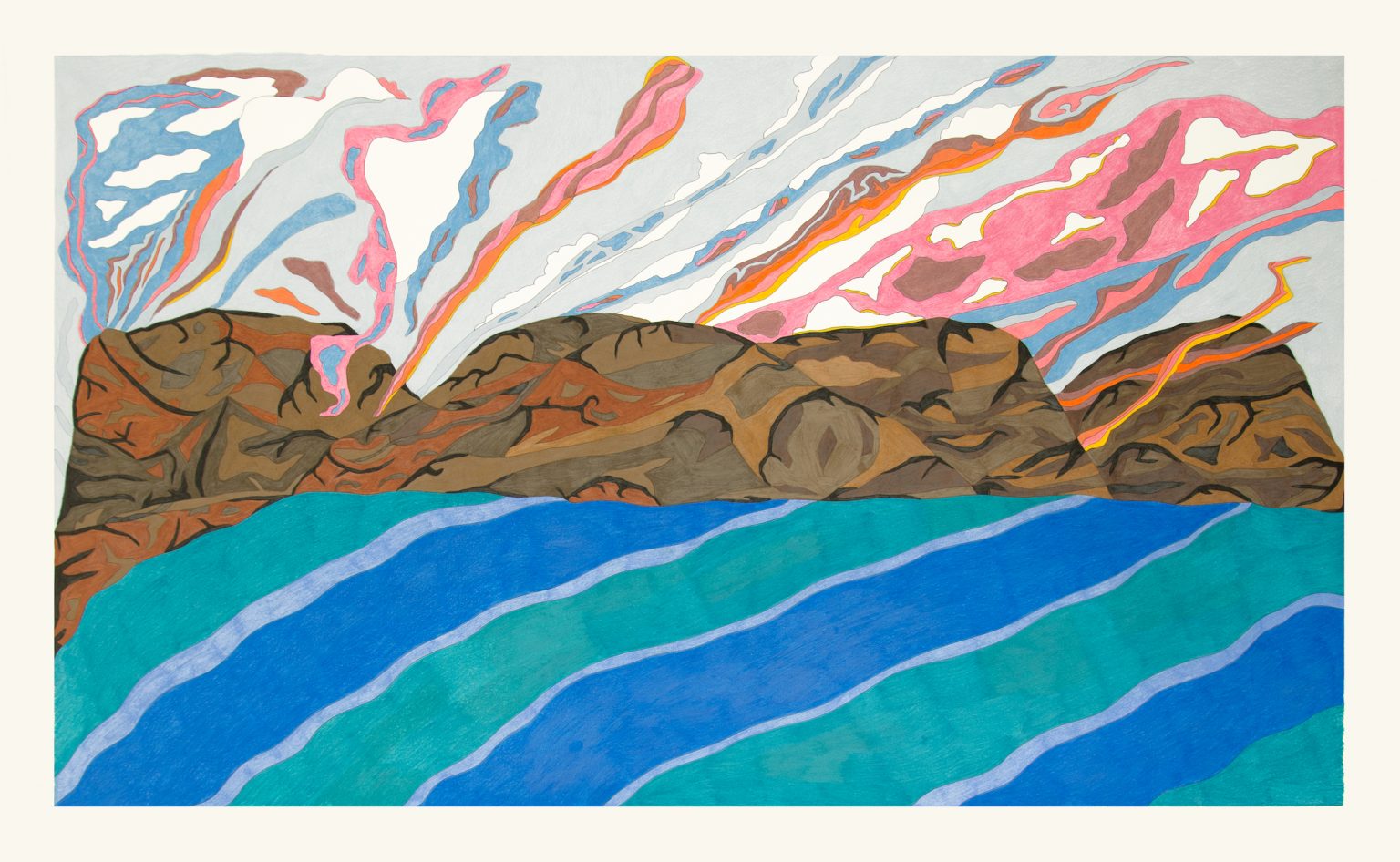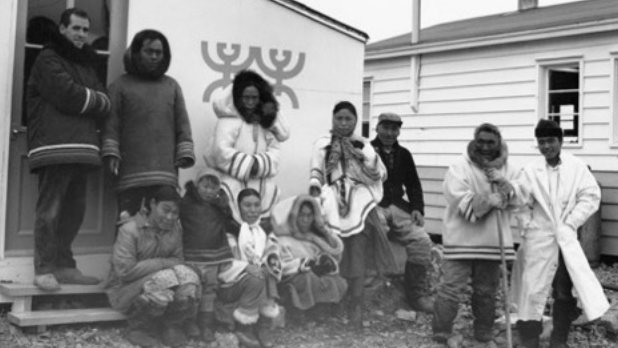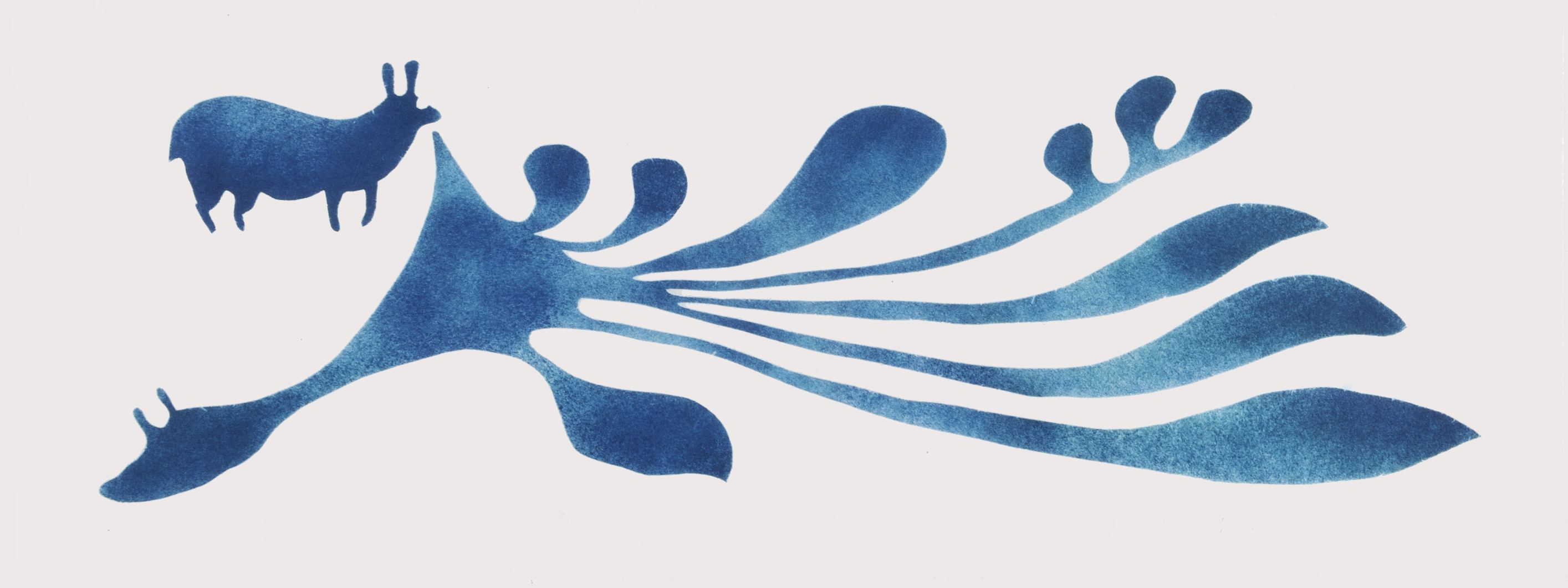INUIT ARTISTS IN THEIR OWN WORDS

Ooloosie Saila, Untitled, 2017, coloured pencil and ink, 77 x 126.8 cm (Reproduced with the permission of Dorset Fine Arts / West Baffin Eskimo Cooperative)
West Baffin Eskimo Co-operative
The West Baffin Eskimo Co-operative, the Arctic Canadian business behind the renowned Cape Dorset print program, is marking its 60th anniversary in 2019.
Follow Eye on the Arctic journalist Eilís Quinn as she explores the world of some of the most renowned Inuit artists part of the co-operative.
Discover the complexity and realities surrounding Inuit art through the personal testimony of the creators themselves.
THE PIONEER
Kenojuak Ashevak
The iconic prints of late Canadian artist Kenojuak Ashevak (1927-2013) almost single-handedly came to define Arctic art both in Canada and on the world stage.
Her work is found in prestigious museum and private collections around the world. Her images have been featured on everything from stamps and Canadian currency, to the stained glass windows at John Bell Chapel in Oakville, Ontario. In this 2010 conversation filmed at her home in Cape Dorset, Nunavut, Ashevak sat down with Eye on the Arctic’s Eilís Quinn to discuss her work, her success and what she really thinks about the next generation of northern artists.
“We’re in an Inuit art renaissance”
THE PRINTER
Niveaksie Quvianaqtuliaq
The Cape Dorset art story has been told thousands of times over. But no matter who tells it and how, the printers who actually produce the physical lithographs and stone cuts, often get left out of the narrative.
But many art experts consider these printers the unsung heros of the Cape Dorset success story. So Eye on the Arctic wanted its audience to meet one. Niveaksie Quvianaqtuliaq has been working at Kinngait Studios for almost two decades. Here, in a 2010 conversation with Eye on the Arctic’s Eilís Quinn, Quvianaqtuliaq explains how he, and his fellow printers, work to create the perfect image and what working on the Cape Dorset print collection has meant to him both professionally and personally.
THE CARVER
Toonoo Sharky
Carving is usually the first thing that comes to mind when people think about northern art. But just like other art forms in the Arctic, carving is evolving and changing.
Toonoo Sharky is a longtime carver based in Cape Dorset, Nunavut and has developed an instantly recognizable style that’s become a favourite of collectors. In fact, it’s hard to find an Inuit art gallery in Canada, that doesn’t have his work as part of their collection. In this 2010 conversation with Eye on the Arctic’s Eilís Quinn, Sharky talked about his craft and his hopes for the next generation of northern carvers.
THE UP-AND-COMER
Ningeokuluk Teevee
There’s little consensus on what the future of Inuit art will or should look like. But there’s one thing almost everyone can agree on — Ningeokuluk Teevee will certainly be part of it.
Her work has broad appeal; collectors of traditional Inuit art snap up her work depicting ancient legends while those looking for edgier northern art gravitate to her drawings depicting contemporary life in the North. She admits she’s not a big fan of doing interviews when everything she has to say is already out there in her work. But in 2010, she sat down with Eye on the Arctic’s Eilís Quinn to discuss how climate change is affecting Cape Dorset and increasingly inspiring her art.
THE REBEL
Jutai Toonoo
Artists often say they create art for themselves and don’t care what other people think.
But when Eye on the Arctic’s Eilís Quinn tracked down Jutai Toonoo working in Nunavut’s Kinngait Studios in 2010, we got the sense that he really, really meant it. Toonoo used human imagery to explore identity issues and cultural conflict in the North for much of his career. But at the time of his sudden death in 2015, he’d begun exploring more personal themes in his work, like cancer, a disease that had begun to ravage friends and family members. Many experts say he produced some of the most provocative contemporary artwork to ever come out of the Arctic. In this no-holds-barred conversation, Toonoo talks us through his process, his inspiration and what he really thinks of the art world.
The beginnings of an art phenomenon

A 1961 photo of artists in front of the Cape Dorset print shop run by the West Baffin Eskimo Co-operative in Arctic Canada. From left to right standing: Print studio manager Terry Ryan and artists Pudlo Pudlat, Pitseolak Ashoona, Napachie Pootoogook, Kiakshuk, Parr, Joanasie Salomomie. Seated from left to right: artists Eegyvadluk Ragee, Kenojuak Ashevak, Lucy Qinnuayuak. (Courtesy West Baffin Eskimo Co-operative)
The co-op was established in 1959 in Cape Dorset, an island community off the southwest coast of Baffin Island in Canada’s eastern Arctic.
The first annual Cape Dorset print collection was released the same year, made up of images produced by Inuit in the region, who’d been taught printmaking by Canadian artist James Houston after he’d moved to the area.
The Cape Dorset prints of Arctic nature and traditional Inuit life became a hit in the art world and a favourite of collectors. Artists like Kenojuak Ashevak (1927 -2013 ) whose work appeared in the first collection, went on to have an international career spanning decades.
Over the last decade, the print collection has also featured works by artists exploring contemporary themes like Shuvinai Ashoona’s depictions of day-to-day life in Cape Dorset or, images from Jutai Toonoo (1959-2015) whose prints and sculptures often featured abstract images of heads and figures along with words or phrases about social, personal and political issues.
Cape Dorset now has a population of approximately 1400, and the co-op, along with the municipality of Cape Dorset, opened the Kenojuak Cultural Centre and Print Shop in 2018, which houses community and exhibition spaces and printing studios.
The New Raw
Rethinking contemporary Inuit art
DOCUMENTARY - Art in the North is changing.
While traditional work and themes are still popular around the world, Inuit artists are increasingly interested in creating art that reflects today’s reality in the Arctic.
In this 2010 documentary report, Eye on the Arctic’s Eilís Quinn travelled to Cape Dorset, Nunavut to speak with the Arctic artists whose work is exploring the rapid social and environmental change in their communities.

13,650
Estimated number of Inuit involved in arts and crafts production in Canada
1,441
Population of Cape Dorset
1982
Year artist Kenojuak Ashevak became Companion of the Order of Canada
2017
Year artist Kananginak Pootoogook was featured in Italy's Biennale di Venezia
Kenojuak Ashevak, Rabbit Eating Seaweed, 1959, sealskin stencil, 20.3 x 55.8 cm (Reproduced with the permission of Dorset Fine Arts / West Baffin Eskimo Cooperative)
Renowned Inuit Artists
....
THE DREAMER
Jolly Atagooyuk
Artist Jolly Atagooyuk was born in Qikiqtarjuaq but lives and works in the community of Pangnirtung in Canada’s eastern Arctic territory of Nunavut.
THE OBSERVER
Jimmy Kamimmalik
The art and artists from Canada’s Arctic are famous around the world.
Starting in the 1960s, the print programs set up in Inuit communities like Cape Dorset, Baker Lake, Ulukhaktok (Holman) and Puvirnituq cultivated some of Canada’s most well-known Canadian artists and printmakers of the 20th century including people like Kenojuak Ashevak, Helen Kalvak and Jessie Oonark. The Cape Dorset print program is still going strong, but over time, many of the other Arctic print programs have folded or scaled back. But despite this, important work is still being done in many of these communities. In this installment of Eye on the Arctic’s ongoing online series looking at the art and artists of Canada’s North, we take you into studio with Jimmy Kamimmalik, an artist and printmaker working in Baker Lake, a community in Canada’s eastern Arctic territory of Nunavut. During our 2016 visit, Kamimmalik talks about the community’s artists, images and how the changing Nunavut landscape inspired one of his recent works.
THE MENTOR
Louie Nigiyok
Louie Nigiyok is a printmaker and artist from the Inuit community of Ulukhaktok (Holman), in Canada’s Northwest Territories.
Eye on the Arctic’s Eilís Quinn sat with him in 2012 to discuss his art, his inspirations and the rich history of Holman’s print program.
THE TECHNICIAN
Andrew Qappik
Pangnirtung’s art centre is unique in Canada’s Arctic.
THE WEAVERS
Kyra Fisher
In the 20th century, print programs were established in several communities across the Canadian Arctic.
But Pangnirtung, Nunavut is the only community that, in addition to printmaking, also has an established weaving program, producing unique tapestries featuring everything from traditional Inuit culture to contemporary Nunavut. In this 2011 conversation, the then general manager of Pangnirtung’s Uqqurmiut Arts and Crafts Centre speaks with Eye on the Arctic’s Eilís Quinn about the work that goes into creating one of the community’s signature tapestries.
Kananginak Pootoogook, Musk Ox, 1970s, serpentinite and ivory, h40.5 x w40 x d20 cm (Reproduced with the permission of Dorset Fine Arts / West Baffin Eskimo Cooperative)
Inuit language series
In this series, Eye on the Arctic journalist Eilís Quinn goes in-depth with Inuit youth, rappers, elders, language experts and leaders from across the Arctic to find out where the Inuit language is headed.
Losing their Words
In this 2010 documentary, Eye on the Arctic journalist Eilís Quinn follows the unique linguistic journey of an aspiring MC from Nunavut.
She also interviews Canadian, Alaskan and Greenland Inuit from the world of hip-hop, theatre, film, literature and linguistics, finding unique perspectives on the future of the Inuit language.
She examines the truths, divisions and controversy behind this highly complex issue.
Some think standardizing the Inuit language is the solution, others worry standardization will erode regional Inuit cultures and kill off local Inuit dialects for good.
https://www.youtube.com/watch?v=aIE19wmMeOk
THE POET
Aqqaluk Lynge is a poet and the current chair of the Inuit Circumpolar Council and the president of the ICC– Greenland.
In this in-depth interview with Eye on the Arctic journalist Eilís Quinn, Lynge reads from his poem “The Sound of my Song” and discusses how standardizing the Inuit language writing system would increase Inuit political and cultural clout on the world stage and help heal the scars of colonialism across the Arctic.
THE RAPPER
Meet TuuMotz, one of the founders of Nuuk Posse, Greenland’s seminal hip-hop group and now a solo artist.
Here, Eye on the Arctic journalist Eilís Quinn talks to TuuMotz about his life, why rapping in the Inuit language is so important to him and how hip-hop can build bridges between young people across the Arctic.
